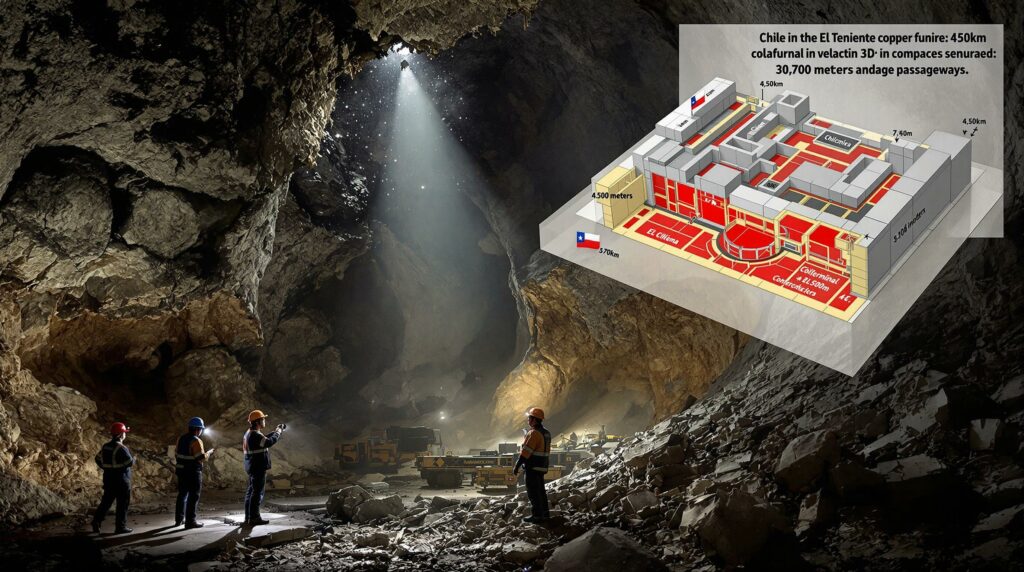Fatal Codelco Mine Accident: Chilean Prosecutors Launch In-Depth Investigation
The recent tragedy at Chile's El Teniente copper mine has prompted an extensive investigation as prosecutors work to determine what caused the catastrophic tunnel collapse that claimed six workers' lives. The scope of the disaster has proven far more extensive than initially reported, raising serious questions about safety protocols and operational practices at the world's largest underground mine.
Understanding the El Teniente Mine Disaster
The devastating accident at El Teniente copper mine has shaken Chile's mining industry, with prosecutors uncovering damage far exceeding initial estimates. The collapse affected multiple critical sections of the mine's vast tunnel network, creating a complex investigation scenario for authorities.
The Scale of the Accident
The El Teniente disaster resulted in six worker fatalities, making it one of the most serious mining accidents in recent Chilean history. According to information revealed by Prosecutor Aquiles Cubillos, investigators documented approximately 3,700 meters of damaged passageways—over five times more extensive than Codelco's initial estimate of just 700 meters.
The damage pattern spans multiple operational areas within the mine:
- Andesita unit: 2-3 distinct areas suffered significant structural damage
- Recursos Norte unit: 5-6 separate areas experienced collapse or severe structural compromise
- Four distinct levels: Documented with comprehensive photographic evidence
This extensive damage represents a small but critical portion of El Teniente's massive underground infrastructure, which contains approximately 4,500 kilometers of tunnels carved through the Andes mountains. The sheer scale of the mine—the world's largest underground copper operation—complicates both the investigation and potential remediation efforts.
The Investigation Process
Prosecutor Aquiles Cubillos of Chile's O'Higgins region has taken a methodical approach to the investigation, meeting directly with Codelco technical experts to understand the mine's operations and the sequence of events leading to the disaster. The investigation team has:
- Documented four damaged levels with extensive photographic evidence
- Initiated the creation of comprehensive damage assessment maps
- Questioned Codelco officials about operational details that emerged during the investigation
- Examined both the collapse zones and the specific locations where injuries and fatalities occurred
"There are things that have come up from the investigation," Cubillos noted, indicating that prosecutors are seeking explanations for operational decisions and practices that may have contributed to the disaster. This statement suggests investigators may have identified potential safety oversights or procedural issues requiring further scrutiny.
How Does This Impact Codelco's Operations?
The El Teniente disaster has significant implications for Codelco, Chile's state-owned mining giant and the world's largest copper producer. The immediate operational shutdown has already disrupted production, with potential long-term consequences for both the company and global copper market insights.
Current Mine Status
As of August 8, 2025, El Teniente remained completely offline, with no concrete timeline for resuming full operations. Codelco has submitted a request to Chile's mining regulator seeking approval for a partial restart of operations in unaffected areas of the mine. However, this request remains under review, with regulators likely to demand extensive safety assurances before permitting any resumption of activities.
The extended shutdown poses significant challenges for Codelco's production targets and financial performance. El Teniente is one of the company's flagship operations, and each day of lost production represents substantial revenue impacts for both the company and the Chilean economy, which relies heavily on copper exports.
Safety and Regulatory Questions
The significant discrepancy between Codelco's initial damage assessment (700 meters) and the actual extent of damage (3,700 meters) raises serious questions about the company's internal reporting mechanisms and damage assessment protocols. This five-fold underestimation has become a focal point for investigators, who are examining whether it represents a communication failure or a more concerning attempt to downplay the accident's severity.
The investigation is likely to address several critical questions:
- Were established safety protocols followed in the lead-up to the collapse?
- Did early warning systems fail to detect structural instability?
- Were maintenance and tunnel reinforcement schedules adequate?
- Did operational pressures compromise safety considerations?
The answers to these questions could trigger significant regulatory changes within Chile's mining industry, potentially including enhanced inspection requirements, stricter enforcement mechanisms, and more rigorous reporting standards for incidents and near-misses.
What Are the Broader Implications for Chilean Mining?
The El Teniente disaster occurs against the backdrop of Chile's position as the world's leading copper producer, responsible for approximately 28% of global copper output. The accident has implications that extend far beyond Codelco, potentially affecting industry practices, regulatory frameworks, and Chile's standing in the global mining sector.
Industry Safety Standards
This tragic incident highlights the persistent safety challenges in underground mining operations, even in a country with relatively advanced mining practices like Chile. The disaster will likely catalyze a comprehensive review of safety standards across all Chilean mining operations, with particular scrutiny on older mines with extensive tunnel networks.
Key areas likely to see increased attention include:
- Structural integrity monitoring systems and technologies
- Emergency response protocols and evacuation procedures
- Worker safety training and awareness programs
- Maintenance scheduling and enforcement
- Independent safety verification requirements
Chilean authorities may implement more stringent enforcement of existing regulations while developing new safety protocols specifically designed for complex underground mining operations. The industry may also see a push toward increased AI in mining safety to reduce human exposure to potentially dangerous conditions.
Economic Impact
The extended shutdown at El Teniente creates ripple effects throughout Chile's copper-dependent economy. While precise production figures for El Teniente are not publicly available, the mine represents a significant portion of Codelco's total output, which itself accounts for a substantial share of Chile's copper production.
Beyond the direct production losses, the accident impacts:
- Local communities dependent on mining employment
- Supporting industries and service providers
- National export revenues and tax income
- Chile's reputation as a stable and reliable copper producer
The economic consequences extend to the approximately 4,000 workers at El Teniente, many of whom face uncertainty about when they can return to work. The social and economic health of nearby communities, particularly Rancagua, depends heavily on the mine's operations.
How Do Mine Accidents Impact the Global Copper Market?
Major disruptions at facilities like El Teniente can have significant implications for global copper supply chains, particularly in a market characterized by tight supply conditions and growing demand from renewable energy and electric vehicle sectors.
Supply Chain Disruptions
El Teniente's production capacity represents a meaningful portion of global copper supply. While the market can typically absorb short-term disruptions, prolonged outages can create supply constraints, especially if they coincide with issues at other major mines or smelters.
The copper market typically responds to major supply disruptions through:
- Price increases as buyers compete for available supply
- Drawdowns of warehouse inventories to meet immediate demand
- Acceleration of production at other mines where possible
- Increased recycling activity when economically viable
- Substitution with alternative materials in some applications
The timing of the El Teniente disaster is particularly significant, as global copper markets have been experiencing supply tightness amid growing demand from renewable energy infrastructure and electric vehicle manufacturing.
Industry Response
The El Teniente accident will likely trigger responses from other major copper producers worldwide, potentially including:
- Comprehensive safety reviews at similar underground operations
- Accelerated investment in monitoring technologies and predictive maintenance
- Enhanced emergency response planning and worker training
- Greater transparency in incident reporting and investigation
- Balanced approaches to meeting production targets while maintaining safety standards
Mining companies must navigate competing pressures to maintain production levels while ensuring worker safety, particularly as many older mines face increasing geological challenges that complicate extraction and increase operational risks.
FAQ: El Teniente Mine Accident Investigation
What caused the mine collapse at El Teniente?
The specific cause of the collapse remains under active investigation. Chilean prosecutors, led by Aquiles Cubillos, are working methodically with Codelco technical experts to determine the sequence of events and contributing factors that led to the disaster. The investigation is examining structural factors, maintenance records, operational decisions, and emergency response procedures to build a comprehensive understanding of the accident.
Disclaimer: The investigation is ongoing, and official conclusions have not yet been released. Information may change as additional evidence emerges.
How does this accident compare to previous incidents at Chilean mines?
While Chile has made significant strides in mining safety over recent decades, the El Teniente disaster represents one of the more serious accidents in recent years. The investigation will likely compare safety protocols and conditions with previous incidents to identify whether this represents an isolated failure or indicates more systemic issues requiring industry-wide attention.
Complete historical context requires additional analysis of past mining accidents in Chile, their causes, and the effectiveness of subsequent safety improvements implemented.
When will El Teniente resume operations?
As of August 8, 2025, El Teniente remained offline, with no specific timeline announced for resumption of operations. Codelco has requested regulatory approval for a partial restart in unaffected areas, but this approval process typically involves rigorous safety verification steps.
Several factors will influence the restart timeline:
- Completion of the prosecutor's investigation
- Structural assessment of undamaged sections
- Implementation of any required safety improvements
- Regulatory approval process
- Worker retraining and safety briefings
Any restart will likely occur in phases, beginning with areas furthest from the collapse zones and expanding gradually as safety is confirmed.
What percentage of Codelco's production comes from El Teniente?
El Teniente represents one of Codelco's most significant operations and contributes substantially to the company's overall copper production. The extended shutdown will have measurable impacts on both Codelco's total output and Chile's copper export figures.
Mining Safety: Lessons from Major Accidents
The El Teniente disaster underscores the importance of comprehensive safety systems in underground mining operations, particularly in mines with extensive tunnel networks operating in complex geological environments.
Key Safety Protocols for Underground Mining
Effective underground mining safety requires integrated approaches that address multiple risk factors:
Structural Integrity Assessments
- Regular geological stability monitoring using advanced sensors
- Predictive analytics to identify potential weakness patterns
- Scheduled reinforcement of critical tunnel sections
- Ground control management systems with real-time monitoring
Emergency Response Planning
- Clearly marked evacuation routes with redundant options
- Emergency refuge chambers with independent air supplies
- Communication systems that function during infrastructure damage
- Regular evacuation drills and emergency scenario training
Communication Systems
- Redundant communication networks throughout mining operations
- Real-time location tracking of personnel
- Automated alert systems for detecting abnormal conditions
- Clear protocols for emergency communication
Training Requirements
- Specialized training for high-risk mining environments
- Regular safety refresher courses and certification
- Scenario-based training for emergency situations
- Safety-focused leadership development
Technology and Prevention
Modern mining operations increasingly rely on advanced technologies to enhance safety:
Monitoring Systems
- Distributed fiber optic sensing for detecting structural changes
- Microseismic monitoring systems that detect subtle rock movements
- Atmospheric monitoring for detecting gas buildup or air quality issues
- Wireless sensor networks providing real-time environmental data
Remote Operations
- Autonomous or remote-controlled equipment for high-risk areas
- Tele-remote systems allowing operation from safe locations
- Robotics for inspection of potentially unstable areas
- Drone technology for post-incident assessment
Data Analytics
- Machine learning algorithms to identify potential failure patterns
- Historical data analysis to identify risk factors
- Predictive maintenance scheduling based on equipment performance
- Integration of geological, maintenance, and operational data
Modernization Efforts
- Ongoing infrastructure upgrades in aging mines
- Implementation of international best practices
- Investment in modern ventilation and ground support systems
- Digital twins of mine operations for scenario planning and training
El Teniente Mine at a Glance
| Aspect | Details |
|---|---|
| Location | Andes mountains, Chile |
| Type | Underground copper mine |
| Size | World's largest underground mine |
| Tunnel network | Approximately 4,500 kilometers |
| Damaged area | 3,700 meters of passageways |
| Affected units | Andesita (2-3 areas), Recursos Norte (5-6 areas) |
| Fatalities | 6 workers |
| Current status | Operations suspended (as of August 8, 2025) |
| Ownership | Codelco (state-owned) |
| Investigation lead | Prosecutor Aquiles Cubillos, O'Higgins region |
Conclusion: Moving Forward After Tragedy
The El Teniente mine disaster represents a critical moment for Chile's mining industry, with implications extending beyond the immediate tragedy to questions of industry innovation trends and balancing production demands with worker safety. As mine reclamation evolution continues across the sector, both Codelco and the broader mining community must incorporate lessons from this tragedy. Furthermore, the accident highlights the need for more advanced 3D geological modelling to better predict potential structural weaknesses in complex underground environments.
According to a recent Reuters report, the chile prosecutor meets with codelco as it probes fatal mine accident to gather crucial evidence about operational practices before the collapse. Additionally, a Deutsche Welle investigation reported that the search operation was one of the most challenging in Chilean mining history, requiring specialized equipment and expertise.
Disclaimer: This article is based on information available as of August 8, 2025. The investigation into the El Teniente mine accident is ongoing, and conclusions about causes, responsibility, and necessary reforms may change as additional evidence emerges. Readers should consult official sources for the most current information.
Want to Stay Ahead of Major Market-Moving Discoveries?
Discovery Alert's proprietary Discovery IQ model instantly notifies investors of significant ASX mineral discoveries, turning complex data into actionable insights before the broader market reacts. Explore how historic discoveries have generated substantial returns by visiting Discovery Alert's dedicated discoveries page.




